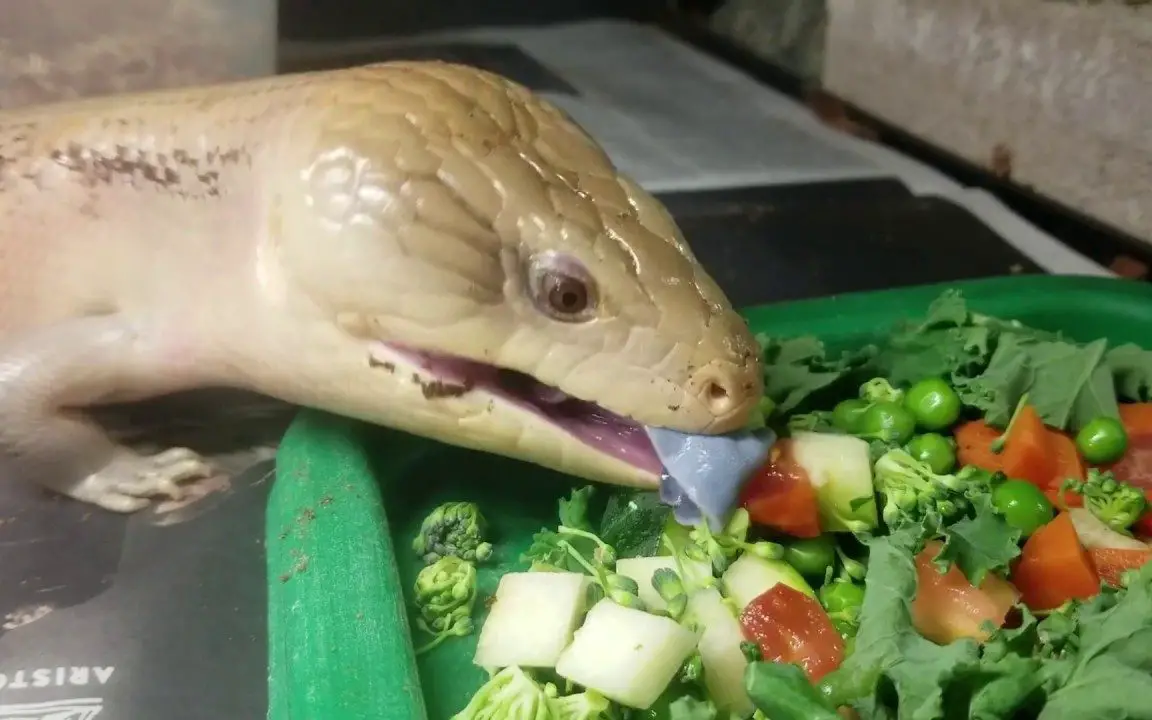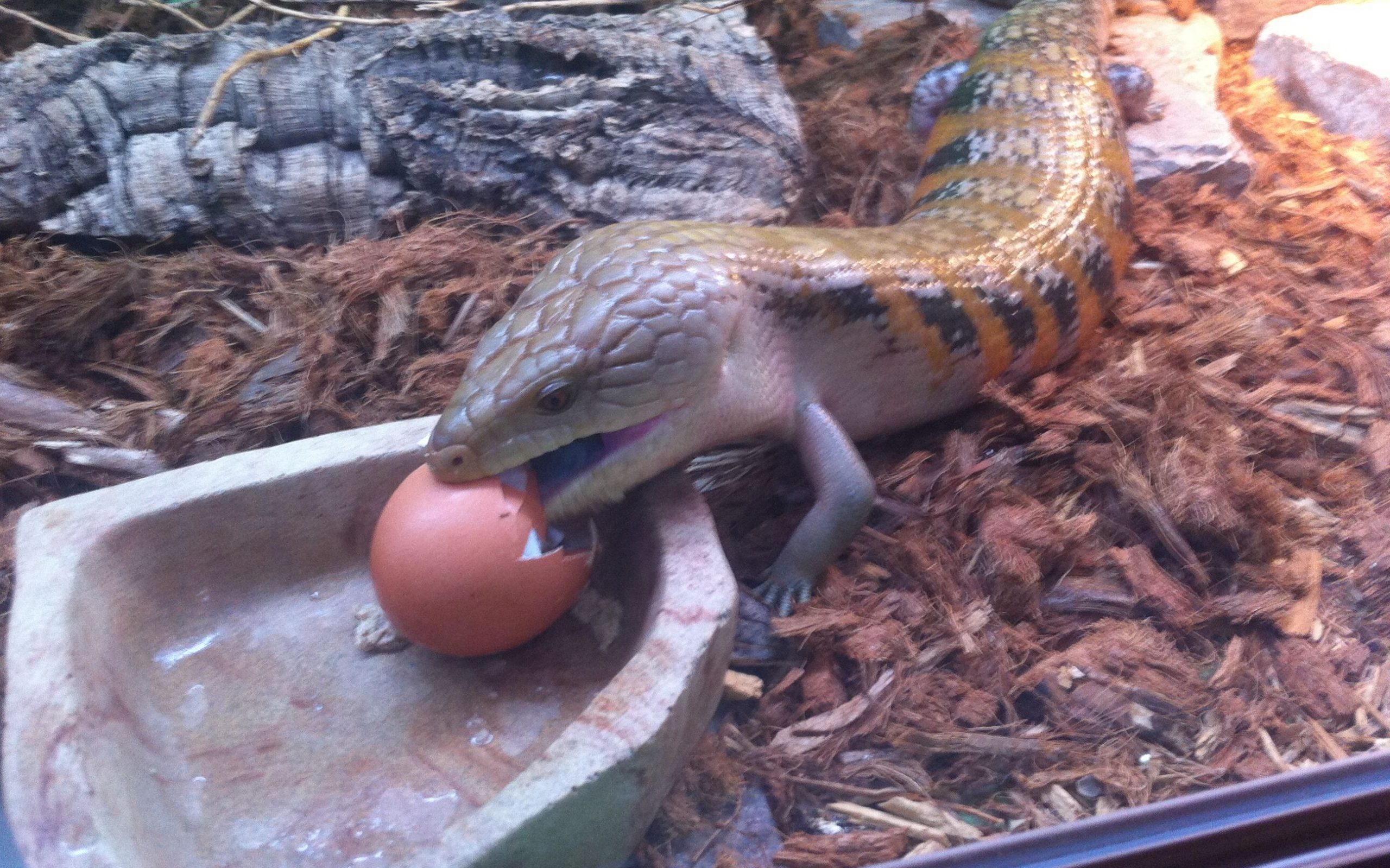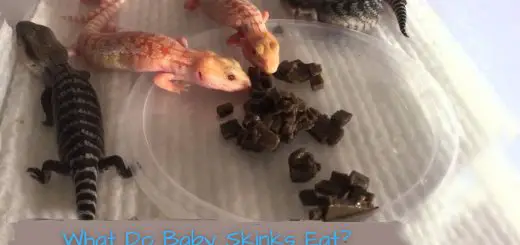What Do Blue Tongue Skinks Eat? The Full Guide

Choosing a new scaly companion for your household is a big decision! If you’ve settled on the unique-looking blue tongue skink for your new reptilian pet, then you’re also going to need to know what do Blue tongue skinks eat.
The blue tongue skink is a medium-sized skink hailing from Australia and New Guinea, where they are plentiful enough to be seen in suburban backyards. Blue tongued skinks are docile in nature and have been found to make great pets for the amateur reptile keeper.
These skinks are welcomed members of many Australian gardens due to their diet of pest insects, among other things, but what do Blue tongue skinks eat when kept as pets? You should feed your skinks 50% greens, 40% animal products, and 5% fruits.
This article will help you establish a well-balanced and nutritious diet for your Blue tongue skink pet. To achieve this, we are looking at the following topics:
- Factors that determine what do Blue tongue skinks eat
- Blue tongue skink diet when kept as pets
- Foods to avoid feeding your Blue tongue skink
- How often should I feed my Blue tongue skink
- How much should I feed my Blue tongue skink
- Recommended Blue tongue skink food brands
Page Contents
Factors That Determine Blue Tongue Skink Diet

To fully understand what do Blue tongue skinks eat, first you need to know the factors that determine your skink’s diet such as:
- Breed
- Calcium to Phosphorus proportion
- Age
Breed
Important factor that determines what do Blue tongue skinks eat when kept as pets is their breed.
For instance, Shingleback skinks are more herbivorous than other species of blue tongue skink!
Although in the wild they occasionally scavenge and eat insects, the vast majority of their diet is flowers and leafy greens. An adult shingleback’s diet should be only 20-30% protein.
Calcium to Phosphorus Ratio
In terms of what do Blue tongue skinks eat, the calciumtophosphate ratio, also known as the Ca:P ratio, plays a big role.
Calcium and phosphate are both minerals your blue tongue skink will need for their overall health, but it is the way that calcium and phosphate interact with one another that necessitates close observation.
In the bodies of vertebrates, calcium is one of the most plentiful minerals. Calcium is kept in the teeth and bones, ensuring that they remain strong. It is also necessary for a variety of other bodily functions and promotes heart health.
Phosphorus is another important mineral that is used to build strong bones and teeth. Phosphorus will bind to calcium, removing it from the body rendering the calcium useless. It bonds at a 1:1 one ratio.
Because of the 1:1 phosphorus-to-calcium-binding ratio, your blue tongue skink must be fed meals with a 2:1 calcium-to-phosphorus ratio in order to maintain the right quantity of calcium in their body.
Simply put, your skink needs double the amount of calcium for the phosphorus it receives through its diet.
Age
When it comes to what do Blue tongue skinks eat, age plays a big role. For instance, with juvenile skinks half of their diet comes from insects, whereas adults should eat proportionately more plant matter.
Young skinks need around 70% to 80% of protein in their diet. This is because the first 12 months of their life is dedicated to growing and developing.
Blue Tongue Skink Diet In The Wild

Before exploring what do Blue tongue skinks eat when kept as pets, it’s important to know what is their diet in the wild.
In the wild, Blue tongue skinks are omnivores. This means they eat both plants and animals. These skinks will not pass up a chance to eat!
Wild Blue tongue skinks enjoy a wide variety of foods, including:
- Insects
- Fruits
- Nuts
- Berries
- Flowers
- Snails
- Small mammals
- Eggs
- Birds
Blue tongue skinks are also known to eat carrion from time to time. In the wild, they are truly equal opportunity eaters.
Blue Tongue Skink Diet When Kept As Pets
Just like with humans, what do Blue tongue skink eat is all down to balance in foods. While they may wantan only-meat diet, what Blue tongue skinks need is a diet consisting of the following components:
- 50% of vegetables and greens
- 40% of animal products
- 5% of fruits
Just like us human, skinks have different preferences when it comes to food. One way to tell if your skink is happy with their diet is by observing their behavior.
Understanding what your skink is trying to tell you is important part of their care. For instance, if your skink is annoyed they will huff. To learn more about all the reason for skink huffing, keep reading here Blue Tongue Skink Huffing? What Causes It And How To Fix It
Vegetables And Greens

What do Blue tongue skinks eat in terms of vegetables and greens is quite the long list. With a few significant exceptions, most vegetables and greens are suitable for your blue tongue skinks. Squash, in particular, is a form of food that your skink will like while also providing him with important vitamins and nutrients.
Vegetables and greens should make up the majority of a blue tongue skink diet. Vegetables are inexpensive, and it’s easy to give your skink a nice variety so they never get bored.
Dark, leafy greens are a great place to start. These greens are packed with the vitamins and minerals your blue tongue skink will need to stay healthy. Top that awesome skink salad with some fresh squash, and you’ve got a top-notch delicacy for your scaly friend.
Some of the best greens and vegetables to feed your skink include:
- Squash – Squash such as summer, hubbard, spaghetti and scallop squash are great choices
- Collard Greens and Mustard Greens – A leafy plant native to the southern US, collard greens and mustard greens are full of calcium and are the perfect base for your skink’s diet
- Bell Peppers – All colors of bell peppers are good skink food and are easy to grow in your own garden
- Arugula – Arugula is not only an ideal staple, it also has the correct calcium and phosphorus ratio, making it a must for your blue tongue skink diet
Vegetables and greens to avoid include anything in the onion family, as well as mushrooms, which can be toxic. Eggplants and tomatoes should also be avoided.
Animal Products

In terms of what animal products do Blue tongue skinks eat, a veryimportant rule is to never feed your skink any wild caught insects or animals. This is because they can contain any number of toxic pesticides, herbicides, and even parasites.
It’s unlikely that you will ever feed your skink any sort of mammal or bird, although as an occasional treat you can feed pinkies (neonate mice), so we will focus on insects. Most crickets, roaches, and worms that are available at your local pet or reptile store should be safe and healthy for your skink to ingest.
You can also cook up some delicious protein for your skink! Cooked chicken, turkey, and eggs can be fed to your skink but should be limited to once-in-awhile special meals.
When feeding your skink protein, it’s important to feed them the right amount. For instance, if your skink doesn’t get enough protein in their diet, their scales can become deformed — known as “pyramiding.” On the other hand, too much protein can result in becoming overweight and their kidneys can even start to shut down.
What Insects Can Blue Tongue Skinks Eat?
In terms of what do Blue tongue skinks eat, insects definitely make the list! Not only skinks love insects but insects are also a great source of protein.
The types of readily available insects your blue tongue skin can eat include-
- Black Soldier Fly Larvae (Also known as a phoenix worm)
Black soldier fly larvae are protein-dense worms that are a very nutritious food for pet reptiles. They are full of calcium and don’t need to be gut-loaded like other insects.
- Silkworms
These low-fat worms are full of beneficial protein and calcium and are considered to be one of the best feeder insects for skinks and other reptiles. Silkworms will need to be gut-loaded.
- Crickets
Crickets, even though they need to be gut-loaded, provide adequate nutrition for a skinks diet. They are also a great choice of feeder insects because they breed prolifically, making them easy to breed at home for easy-access skink food.
- Roaches
Dubia roaches, ivory-head roaches, discoid roaches, and lobster roaches are excellent feeder insects for a range of reptiles. They are available in a lot of sizes, have a long shelf life, and provide excellent nourishment. They will need to be gut-loaded.
There are other insects available that your blue tongue skink can enjoy as part of their diet, these are just the best and most readily available.
Before feeding your skink any insect you aren’t sure about, always check the calcium to phosphorus ratio and guarantee that the insect isn’t toxic to your skink.
It’s also a good idea to never feed your skink any insect that can bite or sting them. Not only is this very painful for your pet, but it can also cause secondary infections that can have dire consequences for your skink.
Fruits

In terms of what do Blue tongue skinks eat, fruits shouldn’t make up a significant portion of their diet. Although, they can be a tasty treat that also provides nutrition and variety, fruits should only make up 5% of the Blue tongue skink diet.
Being very sugar-heavy, fruits shouldn’t take the place of proteins or vegetables. Make sure to choose the right fruits as some can be unhealthy or even cause serious problems like impaction.
Some of the types of fruit that can be a good addition to your skink’s diet are-
- Apples
Apples aren’t just tasty in pies, they can also be a fun treat for your blue tongue skink. Skinks and other reptiles aren’t going to have a preference on what type of apple you feed them, but softer apples will go bad faster which they like.
- Cantaloupe
Skinks adore cantaloupes, but as with all fruits, they should never make up a significant portion of your skink’s diet. Another thing to consider when feeding cantaloupe to a skink is that cantaloupe is a huge fruit, so expect to have some leftovers.
- Blackberries
These bite-sized berries are the perfect size for adolescent blue tongue skinks and are sure to be a hit at dinnertime. A blackberry or two is a great reward for your well-behaved skink.
- Mango
This tropical fruit can be a little harder to find at your local grocery, but when you do happen across some, why not grab one for your skink? In small amounts, mangoes are perfectly safe for skink snacks.
What Other Foods Can Blue Tongue Skinks Eat?

There are a few other food options that you can include in your Blue tongue skink diet such as:
- Commercial blue tongue skink food – Although there are a lot of different brands, not all commercial pet foods are created equal, so do your own research before adding any commercial food to your skink’s regular diet
- Skinks can havelow-fat cooked meats like turkey and chicken, as well as the occasional cooked egg
- Pinkies, which are neonate mice, are acceptable additions to your blue tongue skink diet, but they shouldn’t be fed often. Live or frozen are both fine, but don’t feed mature mice or rats. Mature mice and rats have sharp claws and teeth that could injure your skink
- Dog or cat foods – Blue tongue skinks can eat certain dogor cat foods, and they really seem to enjoy them! Cat foods should be fed to young skinks, whereas dog food is more suitable for adults
If you’re squeamish about feeding mice or rat pinkies, no worries! Blue tongue skinks don’t need to have these added to their diets. There are plenty of other great sources of protein.
Foods To Avoid In Blue Tongue Skink Diet
Now that we discussed what do Blue tongue skinks eat, it’s time to look at what they can’t eat.
When it comes to animal products, vegetables, greens, and fruits, there are two main categories of foods you should avoid.
The first is called goitrogenic foods. These foods are high in goitrogens. In excess, goitrogens will bind to the iodine in your skink’s system, removing it. A lack of iodine over time can cause thyroid issues.
The second is called oxalic foods. These foods contain excess amounts of oxalates, which like phosphorus, will bind to calcium and remove it from the skink’s body.
A few examples of foods that should be avoided include:
- Corn – high contents of phosphorus
- Spinach – contains oxalic
- Onion family – toxic to blue tongue skinks
- Mushrooms – toxic to blue tongue skinks
- Kiwi –contains oxalic
- Strawberries and Raspberries -contains goitrogenic
- Cherries – contains goitrogenic
- Biting or Stinging Insects – these may attack and cause pain to your skink. Bites and stings can also trigger allergic reactions, as well as providing a place for secondary infections to take hold.
This is only a shortlist of foods that should be avoided. Always do your own research before working out a diet for your blue tongue skink. Better safe than sorry!
How Often Should I Feed My Blue Tongue Skink?
The amount of food you should feed your Blue tongue skink and how often you should feed them depends on their age.
- Baby Blue Tongue Skinks – babies should be fed 6 days a week and fast the remaining day
- Adolescents – 2 or 3 times a week, once a day
- Adults – 1 or 2 times a week, once a day
How Much Should I Feed My Blue Tongue Skink?
- Baby Blue Tongue Skinks – As much as they would like, 2 or 3 times a day
- Adolescents -2 tablespoons, once a day
- Adults -1 or 2 tablespoons, once a day
Recommended Blue Tongue Skink Food Brands
In terms of what do Blue tongue skinks eat, there are plenty of commercial options to choose from.
Some of the brands that we recommend include:
- Arcadia Reptile OmniGold – OmniGold is a well-balanced food for omnivore reptiles such as blue tongue skinks. This brand is 100% all-natural and contains real insects in the ingredients!
- Reptilinks 50/50 Omnivore Blend – Resembling sausage links, Reptilinks 50/50 Omnivore brand is made with 50% vegetable matter and 50% rabbit. It’s a great, natural food for your blue tongue skink.
If you’re looking for a more reptile-specific prepared food, Repashy’s Grub Pie, Meat Pie, Veggie Burger, and fruit powders make great mix-ins to add to dog food for variety. They even have a blue tongue skink-specific formula: Bluey Buffet.
Note: Powdered and ready-made reptile diets already have the correct calcium to phosphorous ratio, meaning that you do not have to add calcium powder to these formulas. Most also contain vitamin D3, but it’s worth checking the ingredients label just in case.
Final Thoughts

What do Blue tongue skinks eat should be a well-balanced and nutritious diet. This is more than just some reptile food pellets.
Like humans, to stay in tip-top shape, Blue tongue skinks need a wide variety of foods that are carefully balanced to suit their needs.
No single food will suffice to feed your skink, therefore utilize this post to assist you in researching the finest diet for your scaly pal, and they will be grateful!
FAQ
Can Blue Tongue Skinks Eat Cat or Dog food?
Yes!
Blue tongue skinks can certainly enjoy cat or dog food as a part of their diets. Grain-free is best, and just like if you were choosing for your dog or cat, check the ingredients to rule out any filler or strange additives. Merrick, Nature’s Instinct, and Blue Buffalo brands are good starting points.
What Blue Tongue Skink Diseases Are Caused By Poor Nutrition?
The number one disease caused by inadequate nutrition in blue tongue skinks is metabolic bone disease.
Metabolic bone disease, or MBD, is caused by a lack of either calcium, vitamin D, or a combination of the two in the diet of a blue tongue skink.
Symptoms of MBD include-
- Lethargy
- Curved or swollen limbs
- Soft jaws
- Muscle spasms
If you suspect MBD, contact your vet immediately.
To learn about other common health problems in Blue tongue skinks such as respiratory infection, keep reading here Blue Tongue Skink Respiratory Infection – Causes, Symptoms, Treatment
Sources/References
https://canobievet.com/wp-content/uploads/2018/02/Skink-Care.pdf



